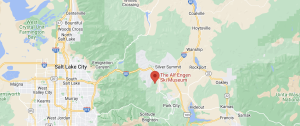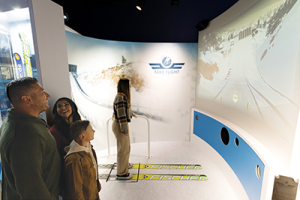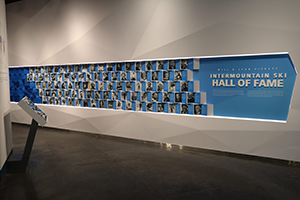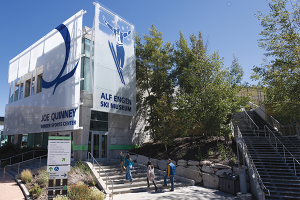- Visit
Visit
Location Information
Hours of Operation
9:00am-6:00pm (Open Daily)
Admission: Free

Schedule a Field Trip
- Explore
Explore Our Museum
Browse Our Exhibits
Discover our Halls of Fame
- Get Involved
Support Our Foundation
Become a Member
Make A Lasting Impact
ECKER HILL
When tournaments were held on Ecker Hill, they were primarily conducted on two take-offs. The bigger was called the “A” take-off (displayed here) and was reserved for jumpers who were in the “Professional” and “Senior” classes or who had been cleared to compete in the amateur “Class A” division. The smaller jump was called the “B” take-off. It was used for training and lower jumper classifications. On several occasions there was a third take-off constructed and basically reserved for one man, Alf Engen. This super large take-off was set back 30 to 50 feet from the others for the purpose of allowing Engen to pursue world record distances.
- Ski jumper medallion used to commemorate the 2001 Ecker Hill historic monument rededication
- This photo, circa 1940, shows the original Ecker Hill, with its distinctive “Utah Ski Club” design on the take-off, during a ski jumping event. Marthinius Strand (on right), holding tripod and camera, was on hand to photograph and document the event at the then world-famous jumping hill. George L. Waters, the photographer, managed Eastman Kodak stores in Salt Lake City at the time
- From the mid-1930s to the late 40s, Ecker Hill hosted many regional and national championships. These events attracted the finest jumpers worldwide, Just a few of the now legendary names in ski history incluse Sigmund Ruud, Norwegian champion; Torger Tokle, American record holder in the early 1940s; Reidar Anderson, 1938 Norwegian champion; Petter Hugsted, 1948 Olympic ski jumping champion; national ski jumping champions Lars Haugen, Sverre Engen, John Elvrum, Sigurd Ulland, and Alf Engen, World’s Professional Ski Jumping Champion in 1931, 1932, and 1933
TAKING FLIGHT
Utah Olympic Park isn’t the first place world-class ski jumping events were held in Utah. Just two miles west of this Olympic facility sits Ecker Hill, established by members of the Utah Ski Club in 1929
GLORY DAYS
The hill was dedicated on March 2, 1930, and was officially named Ecker Hill by Utah Governor George H. Dern in honor of Peter S. Ecker, acting president of the Utah Ski Club. Ecker held this position for ten years.
WORLD RECORDS
Alf Engen, perhaps the best known of the professional jumpers, set world-record distances several times during the 1930s. His top mark was 296 feet, the longest jump ever officially recorded at Ecker Hill
WORLD CLASS
In the 1930s- 1940s, Ecker Hill was one of just a handful of world-class ski jumps in North America. Between 1937 and 1949 Utah hosted national meets on a regular basis. Crowds in excess of 10,000 attended these events
ECKER HILL TODAY
Ecker Hill was last used in the mid-1960s and was listed on the National Register of Historic Places in 1986. The dedication of a permanent historic monument commemorating Ecker Hill took place on September 1, 2001. (See the original wooden monument from 1986 to the left)
WOODEN MONUMENT 1986
ECKER HILL
In 1929, local ski jumping enthusiasts Axel Andresen, Marthinius Strand, and Peter Ecker conceived the idea of creating a world-class jumping facility at this site. Through the diligent efforts of many supporters and the neighboring Rasmussen Family the jump became a reality and in a dedication ceremony on March 2, 1930, governor George H. Dern names the hill after Ecker, President of the Utah Ski Club.
Ecker Hill attracted amateur and professional ski jumpers from all over the world. Alf Engen, who came to Utah from Norway in 1929, Broke five Word Records here and became a recipient of “The Skier of the Century ” award, based largely upon his performance here. On December 25, 1934 Engen broke his own World Record hy jumping 296 feet, a distance which was never exceeded on Ecker Hill.
Calmar Andreasen, one of Utah’s amateur champions lost his life here during a state tournament on February 22, 1934.
This monument serves as a memorial to Calmar Andreasen and as a tribute to the achievements of Alf Engen and the other daring men who jumped at Ecker Hill.
May 25, 1986





